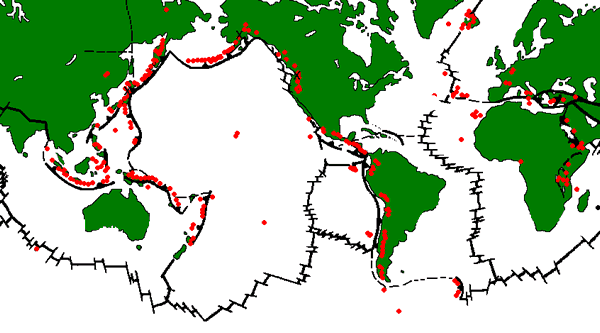BACKGROUND:
The fire and flames that are associated with volcanoes
have always fascinated children and adults alike. How can the Earth produce
such spectacular scenes? Where does it all come from? Do all volcanoes
produce fire? These are complex questions that need much more science
background than your children have at this grade. However, you can explain
that the Earth is restless inside (not in the center of the Earth, but in
the outer portion of the crust and mantle) and has to "relieve"
itself in some way. Just like people burp, The Earth burps volcanoes because
its internal stomach is upset. Some volcanoes have lava that is so hot it
looks like flames as it erupts from the volcano. The "fire" is
actually molten rock, or magma.
All volcanoes do not create lava flows. Some produce
finely broken up rocks or ash. This ash sometimes mixes with melted ice,
resulting in large mudflows. This happened when Mt. St. Helens erupted in
1980.
Volcanoes do not erupt randomly on the Earth's
surface. If you look at a map, you can generally see a pattern. For example
in the Pacific Ocean region, volcanoes seem to be along the coastal areas
from the west coast of North and South America to the east coast of Asia.
This area is referred to as the "Ring of Fire." Students will
later understand that these volcanoes help to define plate boundaries. The
Ring of Fire, for example, is a zone of convergent plate boundaries, where
two plates come together. In this setting, one plate sinks into the Earth,
causing much magma, and hence volcanoes, to form.
PROCEDURE:
- Discuss the following volcanoes, each of which represents a point
along the "Ring of Fire." Show the general location of these
volcanoes on a world map, or use the map and images on the following
pages. Explain that along the edge of the Pacific Ocean there are many
active volcanoes--hence the name "Ring of Fire."
Mt. St. Helens, Washington - erupted in 1980 in western
Washington, presently is building up a lava dome
Mt. Fuji, Japan - has not erupted violently in centuries, it
is sleeping until it erupts one day
Mt. St. Augustine, Alaska - recently erupted in 1989 in a violent
explosion, located along one of the Aleutian islands in southern Alaska

Red dots show active volcanoes throughout the world
-
Using the dot to dot sheet that follows, have the students
color in the volcano. You may want them to label the outside parts of the
volcano, using the words that they discovered in lab. In this volcano
there is gas, ash, and lava. Use the physiographic relief globe to show
students that the magma comes from the upper mantle and crust.
-
Instruct the students to imagine that their drawing is one
of the volcanoes in the "Ring of Fire." Have students make a
circle (= Ring of Fire) sitting on the floor. Have them randomly
"erupt." Discuss that this situation is similar to what is
happening along the "Ring of Fire".
|